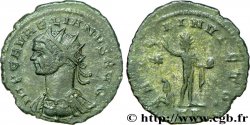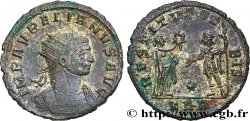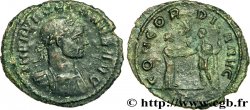brm_639610 - AURELIAN Aurelianus
Not available.
Item sold on our e-shop (2022)
Price : 115.00 €
Item sold on our e-shop (2022)
Price : 115.00 €
Type : Aurelianus
Date: 274
Mint name / Town : Ticinum
Metal : billon
Millesimal fineness : 50 ‰
Diameter : 22 mm
Orientation dies : 6 h.
Weight : 4,09 g.
Rarity : R1
Officine: 1re
Coments on the condition:
Monnaie centrée. Superbe buste finement détaillé, expressif. Joli revers. Patine grise
Catalogue references :
Predigree :
Exemplaire provenant du trésor de Guercheville
Obverse
Obverse legend : IMP C AVRELIANVS AVG.
Obverse description : Buste radié et cuirassé d’Aurélien à droite, vu de trois quarts en avant (B).
Obverse translation : “Imperator Cæsar Aurelianus Augustus”, (L’empereur césar Aurélien auguste).
Reverse
Reverse legend : ORI-E-NS AVG// PXXT.
Reverse description : Sol (le Soleil) radié, nu, le manteau sur l’épaule gauche, debout à gauche, levant la main droite, tenant un globe de la gauche, et posant le pied droit sur un prisonnier assis les mains liées dans le dos ; à ses pieds, à droite, un autre prisonnier assis, les mains liées dans le dos.
Reverse translation : “Oriens Augusti”, (L’Orient de l’auguste).








 Report a mistake
Report a mistake Print the page
Print the page Share my selection
Share my selection Ask a question
Ask a question Consign / sell
Consign / sell
 Full data
Full data



